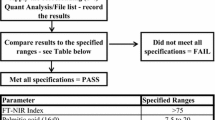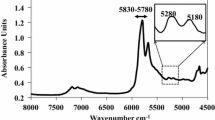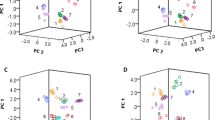Abstract
This paper investigated the application of Fourier transform infrared spectroscopy (FTIR) with partial least squares regression algorithms (PLS) and variable selection methods for the rapid identification of extra virgin olive oil (EVOO) adulterated with different vegetable oils. For this purpose, a unique calibration model was proposed for the identification and quantification of adulteration independent of the adulterating oil. Calibration models were developed for simultaneous determination of the concentration of oleic, linoleic and linolenic fatty acids. Robust models were also developed for quantification of the percentage of adulteration in the samples, independent of the adulterating oil. The calibration set consisted of 68 adulterated EVOO samples, prepared by the addition of vegetable oils (soybean, sunflower, corn, and canola oil) at different levels (1 to 80%, v/v), and ten commercial samples of EVOO were used to validate the models. The mid-infrared spectra were recorded in the wave number range 3200 to 650 cm−1 for all samples. Chromatographic analysis was performed to determine the fatty acid profile of the samples from the calibration and prediction sets. PLS models were developed and different strategies were investigated during the preprocessing of the IR spectra. The results of the prediction were compared with those obtained from the conventional analysis, and RMSEP values of 4.44, 1.92, and 0.62% were obtained for oleic, linoleic, and linolenic acids, respectively. The proposed methodology allowed us to quantify the acids simultaneously in the samples and also demonstrated a good predictive power to identify the adulterated samples.






Similar content being viewed by others
References
Aparicio R, Aparicio-Ruíz R (2000) Authentication of vegetable oils by chromatographic techniques. J Chromatogr A 881:93–104
Aramendia J, Gomez-Nubla L, Arrizabalaga I, Prieto-Taboada N, Castro K, Madariaga J (2013) Multianalytical approach to study the dissolution process of weathering steel: the role of urban pollution. Corros Sci 76:154–162
Azizian H, Mossoba MM, Fardin-Kia AR, Karunathilaka SR, Kramer JKG (2016) Develo** FT-NIR and PLS1 methodology for predicting adulteration in representative varieties/blends of extra virgin olive oils. Lipids 51:1309–1321. https://doi.org/10.1007/s11745-016-4195-0
Bendini A, Cerretani L, Carrasco-Pancorbo A, Gómez-Caravaca AM, Segura-Carretero A, Fernández-Gutiérrez A, Lercker G (2007) Phenolic molecules in virgin olive oils: a survey of their sensory properties, health effects, antioxidant activity and analytical methods. An overview of the last decade. Molecules 12:1679–1719
Bevilacqua M, Bucci R, Magrì AD, Magrì AL, Marini F (2012) Tracing the origin of extra virgin olive oils by infrared spectroscopy and chemometrics: a case study. Anal Chim Acta 717:39–51
Borràs E, Mestres M, Aceña L, Busto O, Ferré J, Boqué R, Calvo A (2015) Identification of olive oil sensory defects by multivariate analysis of mid infrared spectra. Food Chem 187:197–203. https://doi.org/10.1016/j.foodchem.2015.04.030
Caetano S, Üstün B, Hennessy S, Smeyers-Verbeke J, Melssen W, Downey G, Buydens L, Heyden YV (2007) Geographical classification of olive oils by the application of CART and SVM to their FT-IR. J Chemom 21:324–334
Casale M, Sinelli N, Oliveri P, Di Egidio V, Lanteri S (2010) Chemometrical strategies for feature selection and data compression applied to NIR and MIR spectra of extra virgin olive oils for cultivar identification. Talanta 80:1832–1837
Casale M, Oliveri P, Casolino C, Sinelli N, Zunin P, Armanino C, Forina M, Lanteri S (2012) Characterisation of PDO olive oil chianti Classico by non-selective (UV–visible, NIR and MIR spectroscopy) and selective (fatty acid composition) analytical techniques. Anal Chim Acta 712:56–63
Christy AA, Kasemsumran S, Du Y, OZAKI Y (2004) The detection and quantification of adulteration in olive oil by near-infrared spectroscopy and chemometrics. Anal Sci 20:935–940
Christie WW (1989) Gas Chromatography and Lipids. A Practical Guide, The Oily Press, Dundee, p 64
Council IOO (2013) Trade standard applying to olive oil and olive-pomace oil COI/T 15/NC no 3/rev 7, May 2013
Davis R, Mauer L (2010) Fourier transform infrared (FT-IR) spectroscopy: a rapid tool for detection and analysis of foodborne pathogenic bacteria. In:Mendez-Vilas A. (ed) Current research, technology and education topics in applied microbiology and microbial biotechnology. Formatex Research Center. 2:1582–1594
de la Mata P, Dominguez-Vidal A, Bosque-Sendra JM, Ruiz-Medina A, Cuadros-Rodríguez L, Ayora-Cañada MJ (2012) Olive oil assessment in edible oil blends by means of ATR-FTIR and chemometrics. Food Control 23:449–455
FAO/WHO CA (1999) Standard for named vegetable oils, Codex Stan 210-1999. Codex Alimentarius. International Food Standards, Geneva
Frankel EN (2011) Nutritional and biological properties of extra virgin olive oil. J Agric Food Chem 59:785–792
Gómez-Caravaca AM, Maggio RM, Verardo V, Cichelli A, Cerretani L (2013) Fourier transform infrared spectroscopy–partial least squares (FTIR–PLS) coupled procedure application for the evaluation of fly attack on olive oil quality LWT. Food Sci Technol 50:153–159
Gredilla A, de Vallejuelo SF-O, Elejoste N, de Diego A, Madariaga JM (2016) Non-destructive spectroscopy combined with chemometrics as a tool for green chemical analysis of environmental samples: a review. TrAC Trends Anal Chem 76:30–39
Guillen MD, Cabo N (1997) Infrared spectroscopy in the study of edible oils and fats. J Sci Food Agric 75:1–11
Guillén MD, Cabo N (1999) Usefulness of the frequency data of the Fourier transform infrared spectra to evaluate the degree of oxidation of edible oils. J Agric Food Chem 47:709–719
Gurdeniz G, Ozen B (2009) Detection of adulteration of extra-virgin olive oil by chemometric analysis of mid-infrared spectral data. Food Chem 116:519–525
Hadj-Taieb N, Grati N, Ayadi M, Attia I, Bensalem H, Gargouri A (2012) Optimisation of olive oil extraction and minor compounds content of Tunisian olive oil using enzymatic formulations during malaxation. Biochem Eng J 62:79–85
Hirri A, Bassbasi M, Platikanov S, Tauler R, Oussama A (2016) FTIR spectroscopy and PLS-DA classification and prediction of four commercial grade virgin olive oils from Morocco. Food Anal Methods 9:974–981
Inarejos-García A, Gómez-Alonso S, Fregapane G, Salvador M (2013) Evaluation of minor components, sensory characteristics and quality of virgin olive oil by near infrared (NIR) spectroscopy. Food Res Int 50:250–258
Indelicato S, Bongiorno D, Pitonzo R, Di Stefano V, Calabrese V, Indelicato S, Avellone G (2017) Triacylglycerols (TAGs) in edible oils: determination, characterization, quantitation, chemometric approach and evaluation of adulterations. J Chromatogr A 1515:1–16
Inglese P, Famiani F, Galvano F, Servili M, Esposto S, Urbani S (2011) 3 factors affecting extra-virgin olive oil composition. Hortic Rev 38:83
Jabeur H, Zribi A, Bouaziz M (2016) Extra-virgin olive oil and cheap vegetable oils: distinction and detection of adulteration as determined by GC and chemometrics. Food Anal Methods 9:712–723
Lin P, Chen Y, He Y (2012) Identification of geographical origin of olive oil using visible and near-infrared spectroscopy technique combined with chemometrics. Food Bioprocess Technol 5:235–242
Machado M, Machado N, Gouvinhas I, Cunha M, de Almeida JM, Barros AI (2015) Quantification of chemical characteristics of olive fruit and oil of cv Cobrançosa in two ripening stages using MIR spectroscopy and chemometrics. Food Anal Methods 8:1490–1498
Mailer RJ (2004) Rapid evaluation of olive oil quality by NIR reflectance spectroscopy. J Am Oil Chem Soc 81(9):823–827
Maggio RM, Kaufman TS, Del Carlo M, Cerretani L, Bendini A, Cichelli A, Compagnone D (2009) Monitoring of fatty acid composition in virgin olive oil by Fourier transformed infrared spectroscopy coupled with partial least squares. Food Chem 114:1549–1554
Maggio RM, Cerretani L, Chiavaro E, Kaufman TS, Bendini A (2010) A novel chemometric strategy for the estimation of extra virgin olive oil adulteration with edible oils. Food Control 21:890–895
Mendes TO, da Rocha RA, Porto BLS, de Oliveira MAL, dos Anjos VC, Bell MJV (2015) Quantification of extra-virgin olive oil adulteration with soybean oil: a comparative study of NIR, MIR, and Raman spectroscopy associated with Chemometric approaches. Food Anal Methods 8:2339–2346. https://doi.org/10.1007/s12161-015-0121-y
Moros J, Garrigues S, de la Guardia M (2010) Vibrational spectroscopy provides a green tool for multi-component analysis. TrAC Trends Anal Chem 29:578–591
Ozulku G, Yildirim RM, Toker OS, Karasu S, Durak MZ (2017) Rapid detection of adulteration of cold pressed sesame oil Adultered with hazelnut, canola, and sunflower oils using ATR-FTIR spectroscopy combined with Chemometric. Food Control 82:212–216
Peng D, Bi Y, Ren X, Yang G, Sun S, Wang X (2015) Detection and quantification of adulteration of sesame oils with vegetable oils using gas chromatography and multivariate data analysis. Food Chem 188:415–421
Rinnan Å, van der Berg F, Engelsen SB (2009) Review of the most common pre-processing techniques for near-infrared spectra. TrAC Trends Anal Chem 28:1201–1222. https://doi.org/10.1016/j.trac.2009.07.007
Rohman A, Man YBC (2011) Potential use of FTIR-ATR spectroscopic method for determination of virgin coconut oil and extra virgin olive oil in ternary mixture systems. Food Anal Methods 4:155–162
Rohman A, Man YC, Yusof FM (2014) The use of FTIR spectroscopy and chemometrics for rapid authentication of extra virgin olive oil. J Am Oil Chem Soc 91:207–213
Rossell J, King B, Downes MJ (1983) Detection of adulteration. J Am Oil Chem Soc 60:333–339
Sinelli N, Cerretani L, Di Egidio V, Bendini A, Casiraghi E (2010) Application of near (NIR) infrared and mid (MIR) infrared spectroscopy as a rapid tool to classify extra virgin olive oil on the basis of fruity attribute intensity. Food Res Int 43:369–375
Uncu O, Ozen B (2015) Prediction of various chemical parameters of olive oils with Fourier transform infrared spectroscopy. LWT Food Sci Technol 63:978–984
Valcárcel M, Cárdenas S (2005) Vanguard-rearguard analytical strategies. TrAC Trends Anal Chem 24:67–74
Valli E, Bendini A, Berardinelli A, Ragni L, Ricco B, Grossi M, Gallina Toschi T (2016) Rapid and innovative instrumental approaches for quality and authenticity of olive oils. Eur J Lipid Sci Technol 118:1601–1619
Vlachos N, Skopelitis Y, Psaroudaki M, Konstantinidou V, Chatzilazarou A, Tegou E (2006) Applications of Fourier transform-infrared spectroscopy to edible oils. Anal Chim Acta 573:459–465
Yang H, Irudayaraj J, Paradkar MM (2005) Discriminant analysis of edible oils and fats by FTIR, FT-NIR and FT-Raman spectroscopy. Food Chem 93:25–32
Yap KY-L, Chan SY, Lim CS (2007) Infrared-based protocol for the identification and categorization of ginseng and its products. Food Res Int 40:643–652
Acknowledgments
The authors would like to thank Conselho Nacional de Desenvolvimento Científico e Tecnológico (CNPq), Fundação de Amparo à Pesquisa do Estado do Rio Grande do Sul (FAPERGS), and Coordenação de Aperfeiçoamento de Pessoal de Nível Superior (CAPES).
Author information
Authors and Affiliations
Corresponding author
Ethics declarations
Conflict of Interest
The authors declare no conflict of interest.
Ethical Approval
This article does not contain any studies with human or animal subjects.
Informed Consent
Publication has been approved by all individual participants.
Rights and permissions
About this article
Cite this article
Filoda, P.F., Fetter, L.F., Fornasier, F. et al. Fast Methodology for Identification of Olive Oil Adulterated with a Mix of Different Vegetable Oils. Food Anal. Methods 12, 293–304 (2019). https://doi.org/10.1007/s12161-018-1360-5
Received:
Accepted:
Published:
Issue Date:
DOI: https://doi.org/10.1007/s12161-018-1360-5




